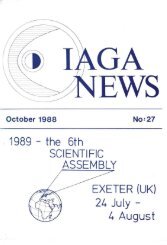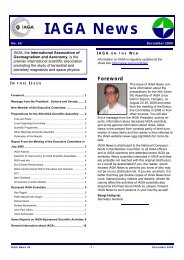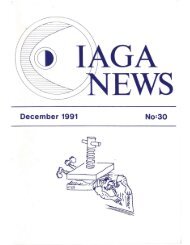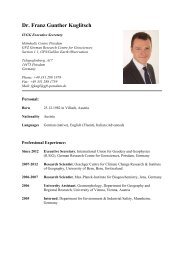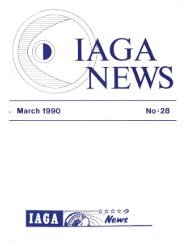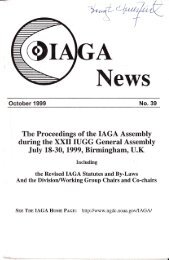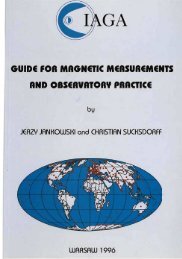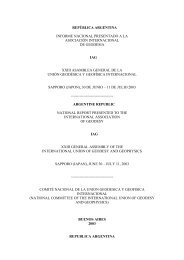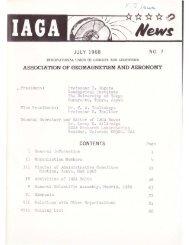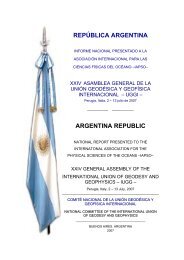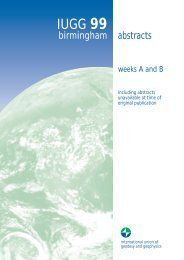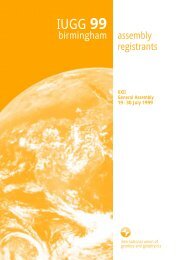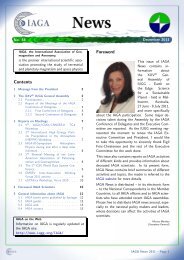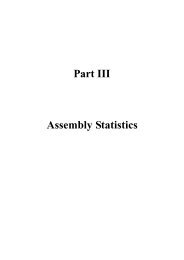xxth GENERAL ASSEMBLY OF IUGG VIENNA (AUSTRIA)
xxth GENERAL ASSEMBLY OF IUGG VIENNA (AUSTRIA)
xxth GENERAL ASSEMBLY OF IUGG VIENNA (AUSTRIA)
- TAGS
- xxth
- assembly
- iugg
- vienna
- www.iugg.org
You also want an ePaper? Increase the reach of your titles
YUMPU automatically turns print PDFs into web optimized ePapers that Google loves.
COSPAR XXVIII Plenary Meeting<br />
Symposium MC5: 3-4 July 1990<br />
(The<br />
REPORT <strong>OF</strong> MEET ING<br />
Hague , Netherlands):<br />
ENLARGED GROUND AND SPACE DATA BASE FOR IONOSPHERIC MODELLING<br />
L Bossy<br />
IASB<br />
3 Avenue Cir cul aire<br />
B-1180 Bruxelles<br />
BELG I UM<br />
The symposium was organised by t h e URSI/COSPAR Task group on<br />
the International Reference Ionosphere [ IRI ] and provi ded a<br />
forum for the annual review of IRI-related activities . Special<br />
emphasis was given to defining the data requirements for the<br />
next cycl e of IRI improvements. The latest version [IRI-90] is<br />
described in a Handbook by D Bilitza which was pre sented at<br />
this meeting and will be released by the National Space<br />
Science Data Center [ NSSDC] before the end of 1990 .<br />
About 30 papers were presented and they will be published in<br />
Advances in Space Science , with K Rawer and W R Piggott as<br />
editors. The following account summarizes the presentations ,<br />
discussions and proposed act ions.<br />
1. Electron density<br />
1.1 Lower ionosphere: K Friedrich prese nted a compilation of<br />
about 80 profiles measured worldwide by rocket-borne radio<br />
wave propagation experiments . He gave simple functions<br />
describing variations with solar zenith angle at different<br />
latitudes. A second set of profiles has been assembled by W<br />
Singer from terrestrial radio wave propagation measure ments at<br />
diffe rent frequenci es.<br />
1.2 Middle ionosphere: Several anchor poi nts dete rmine the IRI<br />
prof ile and qui te a few of these need a lar ger data base and<br />
fu r ther i nvestigations. Concerning foE, it was decided to reexamine<br />
the nighttime variation, which in IRI is based o n a<br />
rather o l d and small data s e t . During daytime, IRI uses the<br />
Kouris and Muggleton formula whic h agrees wel l with the<br />
formula used by CCIR. Concerning the E- F val l ey parameters , it<br />
is important to determine which true- h e ight procedure is the<br />
most reliable f or i o nogram anal ysis . This subject is being<br />
taken up by t h e URSI-G4 group. Checking with incohe rent<br />
s catter observations is felt to be crucial for this task.<br />
Concerning the Fl-point, a smoother transition from the<br />
condition "Fl- present" to the condition "Fl - not- present" is<br />
desirable , t o avoid abrupt changes in altitudinal , diurnal and<br />
latitudinal variations. Gonzale s and Radice lla presented a<br />
simple formula for the Fl h e ight which depends on foFl and o n<br />
magnetic d ip; ch ecking with g l oba 1 data is necessary .<br />
Concerning Gulyaeva' s half -de nsity-poi nt, data are needed to<br />
51



